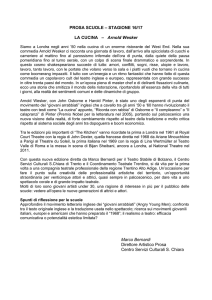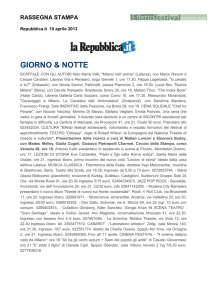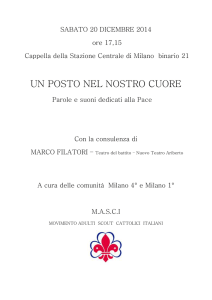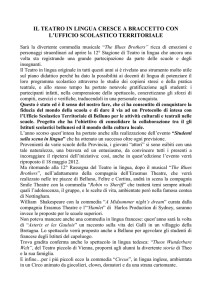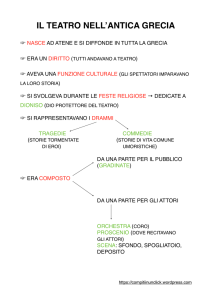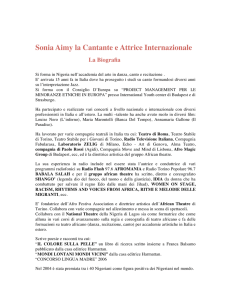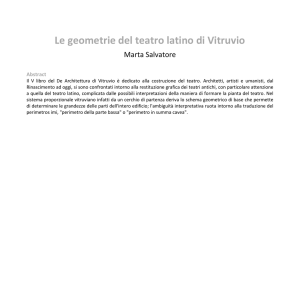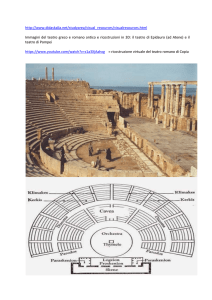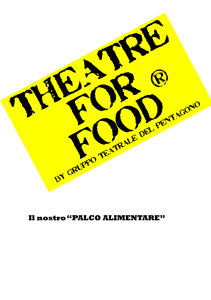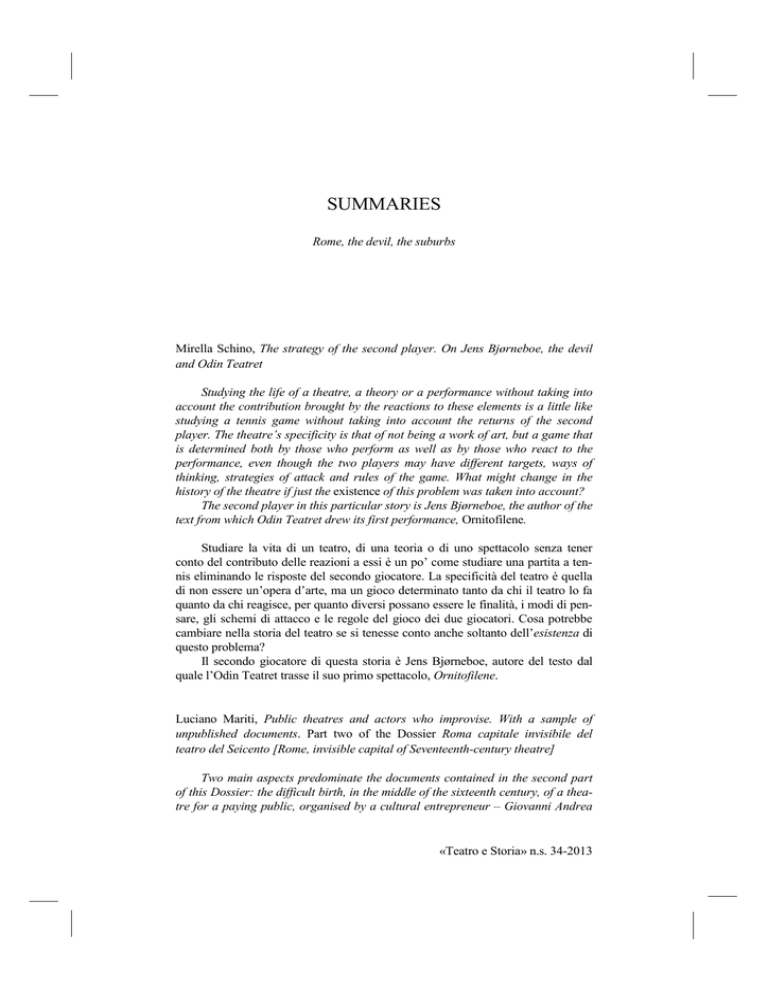
SUMMARIES
Rome, the devil, the suburbs
Mirella Schino, The strategy of the second player. On Jens Bjørneboe, the devil
and Odin Teatret
Studying the life of a theatre, a theory or a performance without taking into
account the contribution brought by the reactions to these elements is a little like
studying a tennis game without taking into account the returns of the second
player. The theatre’s specificity is that of not being a work of art, but a game that
is determined both by those who perform as well as by those who react to the
performance, even though the two players may have different targets, ways of
thinking, strategies of attack and rules of the game. What might change in the
history of the theatre if just the existence of this problem was taken into account?
The second player in this particular story is Jens Bjørneboe, the author of the
text from which Odin Teatret drew its first performance, Ornitofilene.
Studiare la vita di un teatro, di una teoria o di uno spettacolo senza tener
conto del contributo delle reazioni a essi è un po’ come studiare una partita a tennis eliminando le risposte del secondo giocatore. La specificità del teatro è quella
di non essere un’opera d’arte, ma un gioco determinato tanto da chi il teatro lo fa
quanto da chi reagisce, per quanto diversi possano essere le finalità, i modi di pensare, gli schemi di attacco e le regole del gioco dei due giocatori. Cosa potrebbe
cambiare nella storia del teatro se si tenesse conto anche soltanto dell’esistenza di
questo problema?
Il secondo giocatore di questa storia è Jens Bjørneboe, autore del testo dal
quale l’Odin Teatret trasse il suo primo spettacolo, Ornitofilene.
Luciano Mariti, Public theatres and actors who improvise. With a sample of
unpublished documents. Part two of the Dossier Roma capitale invisibile del
teatro del Seicento [Rome, invisible capital of Seventeenth-century theatre]
Two main aspects predominate the documents contained in the second part
of this Dossier: the difficult birth, in the middle of the sixteenth century, of a theatre for a paying public, organised by a cultural entrepreneur – Giovanni Andrea
«Teatro e Storia» n.s. 34-2013
404
SUMMARIES
dell’Anguillara – well before the inauguration of the «rooms» to host performances by Commedia dell’Arte players and the first public theatres in Venice. The
second concerns the phenomenology of a theatre for comedy in Rome that was fully
developed from the beginning of the seventeenth century. Its participants defined
themselves as «the modern actors who improvise». It was in this context that the
theatrical work of the Cavalier d’Arpino, which was to provide the model for the
subsequent theatrical experience of Gian Lorenzo Bernini, matured in the palace the
former had acquired in 1604. This study tries to bring to light at least a fraction of
the network in which the comic Roman theatre was produced and grew: intentions,
reactions, interrelations and practices. This network dissolved and was fragmented
in time, but there are clear indications of a political «public space» that is the fruit
of theatrical activity which the town promotes with its magistrates and its peasants,
its artists and artisans, priests and courtiers, notaries and shopkeepers, princes and
servants. Rome is a city-that-performs: the rich documentation allows the editor to
reformulate and revive the historical framework.
The third part of Roma capitale invisible del teatro del Seicento will be published in the next number of «Teatro e Storia».
Fra i documenti di questa seconda parte prevalgono due aspetti: il primo è la
faticosa nascita, a metà Cinquecento, di un teatro pubblico a pagamento, organizzato
da un impresario di cultura: Giovanni Andrea dell’Anguillara, ben prima che fossero
aperte le «stanze» per accogliere le rappresentazioni di comici dell’Arte e inaugurati
i primi teatri pubblici veneziani. Il secondo riguarda la fenomenologia di un teatro
comico romano che si autodefinisce «dei moderni comici improvvisatori» pienamente sviluppato fin dagli inizi del Seicento. In questo contesto si realizza anche
l’attività teatrale del Cavalier d’Arpino nel palazzo da lui acquistato nel 1604, che
sarà il modello della successiva esperienza teatrale di Gian Lorenzo Bernini. Il saggio si propone di far rivivere almeno un’ombra della rete in cui si produce e cresce il
teatro comico romano: intenzioni, reazioni, interrelazioni e pratiche. Questa rete si è
dissolta e frammentata nel tempo, ma appaiono indizi di uno «spazio pubblico», politico, frutto di una attività teatrale che la città promuove con i suoi magistrati e i suoi
contadini, con i suoi artisti e artigiani, preti e cortigiani, notai e bottegai, principi e
servitori. Roma è una città-che-recita: la ricca documentazione permette al curatore
di riformulare e ravvivarne il quadro storiografico.
La terza parte di Roma capitale invisibile del teatro del Seicento verrà pubblicata nel prossimo numero di «Teatro e Storia».
Raffaella Di Tizio, Doriana Legge, Samantha Marenzi, Francesca Romana Rietti,
Gabriele Sofia, The Valle Theatre Dossier. The years of occupation
This Dossier is a first contribution towards the historical analysis of a phenomenon that has, for the time being, been shown as in continuous transformation. The multifaceted reality of the occupied Valle Theatre has constituted an
SUMMARIES
405
absolute novelty in the panorama of Italian theatre. It is here described from five
different perspectives: the confrontation with the preceding occupations of public
spaces in Rome (the search for analogies and differences); the report of the protest initiatives and civil disobedience that preceded and prepared the occupation
of the Valle Theatre; the unexpected intervention of some famous lawyers who
provided support to a battle that had emerged from the limits of the theatre and
flowed into the wider struggle for the defence of historical buildings. Two studies
are dedicated to the communication strategies of the squatters, starting from the
organisation of the evening events and the language used. Nine analytical tables
contain a wealth of documentary material.
Il Dossier è un primo contributo all’analisi storica di quello che, per ora, si è
presentato come un fenomeno in continua trasformazione. La poliedrica realtà del
Valle Occupato per molti versi ha costituito un’assoluta novità nel panorama del
teatro italiano. Qui viene descritta partendo da cinque diverse prospettive: il confronto con le precedenti occupazioni di spazi pubblici romani (alla ricerca di analogie e differenze); la cronaca delle azioni di protesta e di disobbedienza civile che
hanno preceduto e preparato l’occupazione del Valle; l’intervento inaspettato di
alcuni autorevoli giuristi a sostegno di una battaglia che è uscita dai confini del
teatro per confluire nella più ampia lotta per la difesa dei beni comuni. Due riflessioni sono dedicate alle strategie comunicative degli occupanti, a partire
dall’organizzazione delle serate e dal linguaggio utilizzato. Nove schede analitiche
raccolgono un ricco materiale documentario.
Marco Martinelli, Centres and peripheries, children and monuments. Letter 63
«In order to tell you all about the Teatro delle Albe at the Valle Theatre, I
must start from far beyond, from Pikine; from an immense satellite city that grew
around the suburbs of Dakar. I am not going to recount the performances to you;
imagine that, even in the diversity of styles (from a sort of crude Theatre of Cruelty about children soldiers to a solemn historical drama in costume, from metropolitan comic qualities to the village farce), all works were characterised by great
vitality, by a direct and communicative language that could not do without the
public. In Senegal, but perhaps in the whole of Africa, in all the Africas, you cannot separate “actors” from “spectators”. Often, while watching performances, I
found myself looking around to see what the spectators were doing. They moved,
reacted, spoke and shouted, just like the actors on the stage».
«Per raccontarti del Teatro delle Albe al Valle, la prendo da lontano, da Pikine: da un’immensa città satellite cresciuta alla periferia di Dakar. Non sto a raccontarti gli spettacoli: immagina che, pur nella diversità degli stili (da una sorta di
rozzo teatro della crudeltà sugli enfants soldats a uno ieratico dramma storico in
costume, dalla comicità metropolitana alla farsa da villaggio), tutti i lavori erano
406
SUMMARIES
attraversati da una grande vitalità, da un linguaggio diretto e comunicativo che
non poteva fare a meno del pubblico. In Senegal, ma credo in tutta l’Africa, in
tutte le Afriche, non puoi separare gli “attori” dagli “spettatori”. Spesso mi trovavo, nel seguire gli spettacoli, a guardarmi attorno, per vedere cosa facevano gli
spettatori. Agivano, reagivano, parlavano e gridavano, come gli attori sul palco».
Leah Gilula, Rabin’s Murder – Trial and error. On «The Murder of Isaac» by
Motti Lerner
Motti Lerner, an Israeli political playwright and screenwriter, began writing
his play The Murder of Isaac after the murder of the Prime Minister of Israel,
Yitzhak Rabin. The play received one professional stage reading in its original
language, Hebrew, only after it was produced and stage read, in translation, in
Europe and in the USA. Throughout the process of the stage readings and productions, the play underwent changes until it reached its published version in Hebrew
that reflects Lerner’s understanding of Israeli society at that time. The article follows Lerner’s writing process, his insights and the changes that the play underwent throughout the process. From the description of the rehearsals and of the
changes and variations to the play, the reader will understand the disquieting nature of theatre and the sense of political theatre in a country living an extreme
condition such as Israel.
Paola Ventrone, Symbology and function of feasts expressing identity in certain
Italian cities between the 13th and 15th centuries
This contribution provides a comparison between three pre-modern Italian
cities having three different forms of government: republican Florence, republican Venice (but with a closer form of oligarchic government with respect to
Florence) and the duchy of Milan. The point of view adopted is that of rituals
and civic feasts. The article shows how the ruling classes in Florence, Venice
and Milan created civic feasts to legitimate their power, using various communicative and symbolic languages which reflected the political differences of the
three city-states. Their propaganda strategies are analyzed through a manifold
variety of sources (narrative, iconographic, legislative, descriptive) with the ultimate aim of underlining how theatre and spectacle, in the 13th to 16th centuries, constituted a crucial point of political negotiation between governments
and governed.
Il contributo offre una comparazione fra tre città dell’Italia pre-moderna rette
da tre regimi politici differenti: la repubblicana Firenze, l’altrettanto repubblicana
Venezia (però connotata, rispetto a Firenze, da un’istituzionale e non temporanea
chiusura oligarchica del suo assetto governativo) e il ducato di Milano.
SUMMARIES
407
Scegliendo come punto di osservazione i rituali e le feste civiche, il saggio
evidenzia come i ceti dirigenti fiorentino, veneziano e milanese abbiano istituito
feste civiche per legittimare la loro autorità, facendo uso di vari linguaggi comunicativi e simbolici che riflettevano le differenze politiche esistenti fra le tre cittàstato. Le strategie propagandistiche sono analizzate in una molteplice varietà di
fonti (narrative, iconografiche, legislative, descrittive), con l’intento di sottolineare
come il teatro e lo spettacolo, nei secoli XIII-XVI, siano stati luoghi cruciali della
negoziazione politica fra governanti e governati.
Gilda Tentorio, Dramaturgy in time of crisis. Letter from Greece. Letter 64
«Athens, 22nd February 2013. A storm has just blown over. In this city of
Athens which is just recovering from a real storm, my thoughts go to the metaphors used to define Greece’s economic disaster: cyclone, tempest, earthquake,
catastrophe. While companies and shops close down, theatre in Greece seems to
be going through a positive period. New companies are emerging, two hundred
productions are given in one year, new texts and dramaturgies are produced,
thanks to the drive of the younger generations. It is the symptom of an interesting
cultural ferment, but it does not correspond to a situation of prosperous serenity:
the theatre survives at the cost of great sacrifices. Theatre is performed in occupied buildings, garages, or neglected industrial areas, people make do, without
heating, with a roof to repair. Tickets are cheaper, or voluntary donations are
sought from the public. State financing is lacking, but creative initiatives of solidarity among the companies are appearing. Co-production initiatives thrive, as do
networks of theatrical companies with common objectives, as well as festivals».
«Atene, 22 febbraio 2013. È passato da poco un temporale. In questa Atene che
si risveglia da un acquazzone reale, il pensiero va alle metafore usate per definire il
disastro economico della Grecia: ciclone, tempesta, terremoto, catastrofe. Mentre
aziende e negozi chiudono, il teatro in Grecia sembra attraversare un momento positivo. Nascono nuove compagnie, si contano duecento produzioni in un anno, novità
di testi e di drammaturgia, con una grande spinta delle giovani generazioni. È sintomo di un fermento culturale interessante, ma non corrisponde a una situazione di
prospera serenità: il teatro sopravvive con grandi sacrifici. Si fa teatro in edifici occupati, garage o aree industriali dismesse, ci si arrangia, senza riscaldamento, con un
tetto da riparare. I biglietti hanno costi più bassi, sono previsti ingressi gratuiti o ridotti per i disoccupati, oppure, negli spazi alternativi, ci si affida all’urna delle offerte volontarie da parte del pubblico. I finanziamenti statali mancano, ma nascono
azioni di solidarietà creativa fra compagnie. Fioriscono le iniziative in co-produzione, le reti di compagnie teatrali con obiettivi comuni, i festival».
408
SUMMARIES
Francesca Magnini, Systems of transmission of knowledge in contemporary
dance: the choreographer-dancer relationship
Taking as a starting point the critical concept of «quality of movement», the
knowledge produced by the relationship between choreographer and dancer allows the identification of original parameters for the study of artistic body techniques. It allows the determination of a system of critical orientation which gives
importance to key concepts such as «muscular memory» and «choreographic intention». This study will investigate the dynamic character of movement, its «kinetic-affective qualities», its «temporality», in order to better understand original
modes and directions of transmission in contemporary dance.
Le conoscenze che la relazione coreografo-danzatore produce permettono – a
partire dalla nozione critica di «qualità di movimento» – di individuare parametri
originali per lo studio delle tecniche artistiche del corpo. Consentono di delineare
un sistema di orientamento critico che valorizza concetti chiave come la «memoria
muscolare» e «l’intenzione coreografica».
Investigare il carattere dinamico del movimento, le sue «qualità cinetico-affettive», la sua «temporalità», aiuta a comprendere inedite modalità e percorsi
della trasmissione nella danza contemporanea.
Stefania Esposito, At the beginning is the train. Letter 65
«The public occupies the central nave of a Romanesque church: a track of
white sharp stones divides the two rows of spectators and the metaphor of a train
fills the space at the back of the stage where a video diffuses the noise and the
grained, intermittent image of an engine on rails. The performance CENERI
2701194527012013 is written, directed and interpreted by the Deposito Dei Segni, a non-profit organisation founded by Jörg Grünert and Cam Lecce in 1997
and working in the performing and visual arts, and in theatrical and artistic pedagogy. I find myself on the margins of what seems a dead railway track, the dusty
scene of an extinction: a man and a woman retie the fragments of a story that is
put away but inescapable».
«Il pubblico occupa la navata centrale di una chiesa romanica: a dividere le
due file di spettatori corre un binario di pietre bianche e aguzze di piccole dimensioni e la metafora del treno riempie lo spazio retrostante il palco dove un video
diffonde il rumore e l’immagine sgranata, intermittente, della macchina sulle rotaie. Lo spettacolo CENERI 2701194527012013 è scritto, diretto e interpretato dal
Deposito Dei Segni, una onlus che opera nell’ambito delle arti sceniche e visive,
della pedagogia teatrale e artistica, fondata da Jörg Grünert e Cam Lecce nel 1997.
Mi ritrovo sui margini di quello che sembra un binario morto, la scena polverosa
di un’estinzione: un uomo e una donna riannodano i frammenti di una storia archiviata eppure imprescindibile».
SUMMARIES
409
Anna Maria Monteverdi, Oliviero Ponte di Pino, «Ateatro»: twelve years of online theatre. With a contribution by Jeton Neziraj
The site www.ateatro.it was born in 2011, when blogs were beginning to become established, from an idea by Oliviero Ponte di Pino and Anna Maria Monteverdi to accompany and extend a pre-existing blog; it has therefore followed the
whole on-line evolution. Twelve years are not much. But for a theatre journal they
already provide an excellent example of resistance. For an on-line journal, they
represent entire epochs. To recount the autobiography of www.ateatro.it can be a
way to go through the history of the site, with its novelties and the problems faced
by those who worked on-line, as the actor in the «Gran Teatro della Rete» [the
Grand On-Line Theatre].
Il sito www.ateatro.it è nato nel 2011, quando i blog stavano iniziando ad affermarsi, da un’idea di Oliviero Ponte di Pino e Anna Maria Monteverdi, per affiancare e ampliare un blog preesistente: ha, dunque, seguito l’intera evoluzione
della rete. Dodici anni non sono molti, ma per una rivista teatrale sarebbero già
una bella prova di resistenza. Per una rivista on-line, sono intere epoche.
Raccontare l’autobiografia di www.ateatro.it può essere un modo per ripercorrere
la storia della rete, con le sue novità e i problemi che ha dovuto affrontare chi
operava on-line, come attore nel «Gran Teatro della Rete».
Eugenio Barba, Fame and hunger. Letter 66
«I don’t know where I heard for the first time, the anecdote of two tired out
and weakened actors who, however, have not had enough of theatre. They are
coming out of the theatre where they have just acted and comment on the performance, the reaction of the public, the quantity of the applause. They complain
about the disadvantages of the job. “Every evening – says one – I am scared of
losing my voice. I am there, in front of the public, I open my mouth and nothing,
not one sound comes out. A nightmare. A terrible work, ours”. “What is really
terrible – replies the other – is to be every night King and Nobleman on the stage,
and then return home and not have anything to eat”».
«Non so dove l’ho sentito raccontare la prima volta, l’aneddoto dei due attori
logori e infiacchiti eppure non sazi del mestiere. Stanno uscendo dal teatro dove
hanno appena recitato e commentano lo spettacolo, le reazioni del pubblico, la
quantità degli applausi. Si lamentano per gli inconvenienti del mestiere. “Ogni
sera – dice l’uno – mi prende la paura che la voce mi abbandoni. Sono lì, davanti
al pubblico, apro bocca, e niente, non esce neanche un suono. Un incubo. Un lavoro tremendo, il nostro”. “Quel che è davvero tremendo – risponde l’altro – è di
essere tutte le sere Re e Nobiluomo sulla scena, e poi rientrare a casa e non avere
niente da metter sotto i denti”».
«Culture Teatrali.
Studi, interventi e scritture sullo spettacolo»
n. 22, Annale 2013
REALTÀ DELLA SCENA
giornalismo / teatro / informazione
Gerardo Guccini, Teatro e giornalismo in Italia. Una storia in tre tempi
Massimo Marino, L’informazione contro il teatro. Il caso di «Sul concetto di volto
nel Figlio di Dio» a Milano
Oliviero Ponte di Pino, Per una drammaturgia transmediale della crisi italiana
ovvero perché i clown vincono le elezioni
Dossier Alinovi
a cura di Fabio Acca
Fabio Acca, «Ad ogni modo, non sei sola». La Pesatura dei Punti e il caso Alinovi
La Pesatura dei Punti, Un’entità dal sangue caldo
Dossier Pantani
a cura di Gerardo Guccini
Gerardo Guccini, Una tragedia per l’Italia d’oggi: scrittura, realtà e destino nel
teatro di Marco Martinelli
«Vidi genti fangose in quel pantano». Conversazione fra Marco Martinelli e
Gerardo Guccini
Antologia delle recensioni
Drammaturgia
Paolo Puppa, Casa con angolo Shoah
studi
Laura Budriesi, Michel Leiris «incontra» la possessione: il mestiere di etnologo
Rosaria Ruffini, Le Afriche invisibili di Peter Brook
Claudio Longhi, La tentazione del «Portrait», ovvero la scena della memoria
secondo Lagarce
Sara Baranzoni, Pensiero e creazione: il «teatro del futuro» di Gilles Deleuze
«Teatro e Storia» n.s. 34-2013

